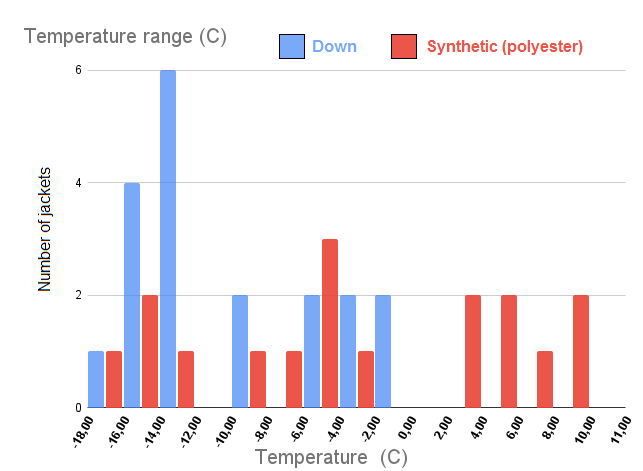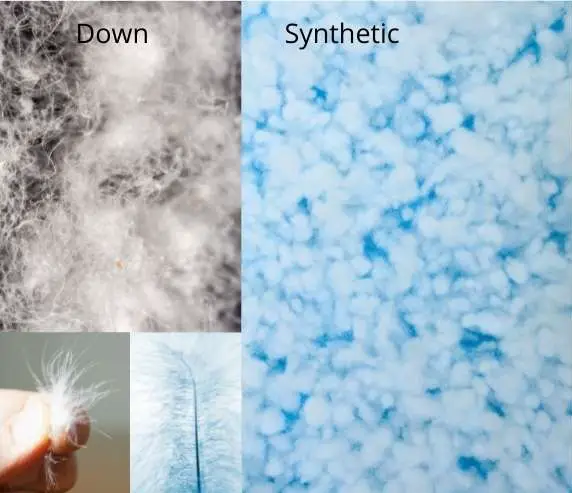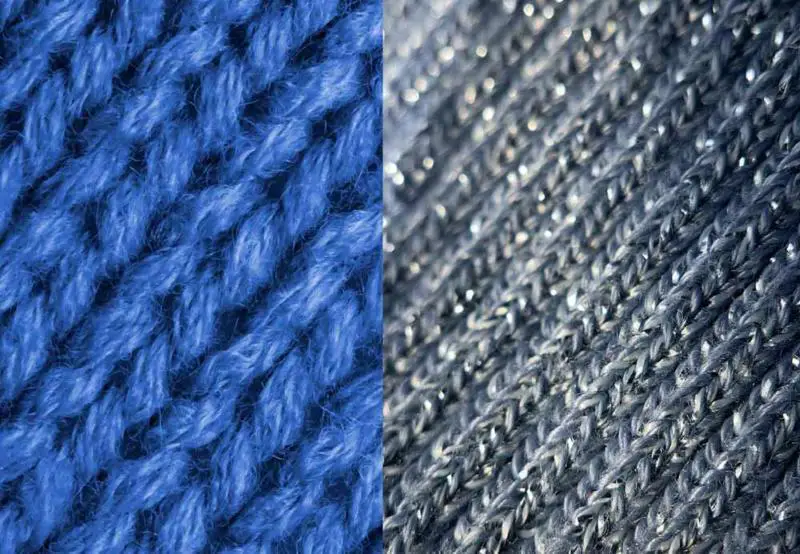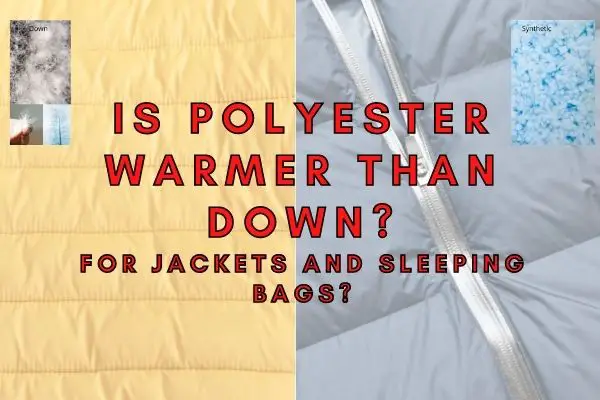If you are looking for a new jacket, blanket/duvet or sleeping bag, there are essentially two filling options to choose from: Down and polyester.
Alternatively, cotton or other natural fibers such as wool may be used for filling in clothing, sleeping bags and blankets. However, down is still the golden standard for lightweight insulation, so down will be the focus of this article.
According to my research, down-filling is 71% more insulating compared to polyester when used in sleeping bags, whereas 100% polyester filling is only approximately 20% colder compared to down when used in the winter jackets of top outdoor brands.
I have always been a strong proponent for natural materials, but as you know, technology has come a long way when it comes to many lightweight yet functional fabrics for hiking.
For example, the extremely thin but strong sheets of nylon or Dyneema (cuben fiber) used for tents is just not comparable to any natural materials.
However, when it comes to insulating capabilities, natural materials like down have yet to see their competition from synthetic materials like polyester when it comes to pure functionality and weight.
When it comes to price, however, it is pretty obvious what is cheapest, and perhaps there are sometimes ethical concerns when using down.
I did a small test, collecting data from 10 different polyester and down sleeping bags, comparing the weight of their filling to their temperature ratings and the chart below shows my findings:

I did a similar analysis for the jackets of major hiking brands, but for jackets I found only a 20% difference in the favor of down!
This might be because of the smaller pockets, flatter design and many other layers that gives a jacket its insulating capabilities. Whereas a sleeping bag is fundamentally just a bag of insulating filling!
So, it is pretty clear to me that the down sleeping bags are much better than synthetic bags when considering insulating ability at the same weight!
But synthetics are not made equally and both nylon and polyester may be used for sleeping bags.

However, some might prefer polyester over down, and there are some reasons to do so!
Let me answer some questions about polyester and its insulating qualities and get more into how it compares to other materials.
Contents
What materials Are Used to Insulate Down Jackets And Sleeping Bags?
When it comes to sleeping bags, polyester and down are the primary materials used for insulation.
For (winter) jackets, these down and polyester/synthetic filling are also the most commonly used, but other materials such as wool, cotton, and even cellulose fibers are sometimes used as well.
The larger range of materials used for insulation in jackets is due to the larger demand for a broader use and price range, higher durability requirements and a lesser emphasis on weight.
Which one of these is used in a sleeping bag or a jacket affects the price, weight, durability, and warmth. But not only the material used; but also how it is treated affects the functionality!
Both insulating materials trap air within a network of fibers. Since motionless air is the best insulator, anything that traps air and forms a barrier between the warm inside of the bag and the cold outside will work!
Therefore, the main consideration is often more about weight per volume, and the ability to keep that volume, rather than “insulation capability” as such.
Whereas sleeping bags have only a single layer of insulation, jackets often use a two- or three-layer construction.
The top layer is sewn through, with the second layer of insulation stitched in between and a more water-resistant layer is often put on top to prevent the insulation material to become wet and ineffective during rain.
The insulation is then offset to prevent cold spots. Single-layer bags are cheaper and usually feature a single sheet with a stitch through the three layers.

The CW300 sleeping bag (read my review here) is an excellent example that a good down bag does not have to be expensive!
Single-layer down bags are generally constructed with a down-filled fill and a lining. Down bags typically contain baffles between the outer shell and inner lining.
How does polyester filling differ from down filling?
Before we dive into the thermal properties of each material, lets look a bit more into the differences in down and polyester filling materials!

When you hear “synthetic filling” think polyester. All synthetic sleeping bag filling is made from thin threads of polyester – a man-made material that does not collapse to the same degree when wet and has a higher tolerance to heat. Read more about the properties of polyester here.
Polyester is in many ways similar to that of other synthetic materials such as nylon, but nylon is not as “springy”, is more expensive, and tolerates humidity less when compared to polyester.
Feathers, down included, are made up of a protein called “keratin”. This is the same material that makes up our nails and hair as well as the horns, scales, and wool of animals.
The physiochemical behavior of keratin is highly dependent on humidity (hydration of the protein), and temperature. The higher the moisture content and temperature, the less elasticity and strength it has.
Whereas down is arguably the best insulator of the two, down filling tends to deform and clump more easily resulting in a lower tolerance to long-term compression,
Synthetic materials tend to do better over time because they don’t experience the same entangling and deformation of the fibers upon compression and when wet.
The downside of synthetic filling, however, is that polyester is heavier per volume and therefore has a much lower fill power compared to down.
You just don’t get the same high insulation ability from synthetic materials, and you will therefore need to use much more of it, which compromises the weight of your bag.
Is 100% polyester filling warm?
Yes! Jackets or sleeping bags insulted with polyester can definitely keep you warm even at the lowest of winter temperatures. But it will be at a heavier weight than down.

The main advantage of polyester filling is its ability to trap air between its fibers, which is a poor conductor of heat.
This trapped air acts as a thermal insulator, preventing body heat loss through temperature gradients.
The amount of heat provided by polyester fabric depends on several factors, including the density and thickness of the fibers in the filling used.
Does a polyester jacket keep you warm?
Yes! A jacket made from polyester can definitely keep you warm, although it really depends on the amount of filling used to insulate it.
For example, if 600 grams of polyester filling is used instead of 200 grams of filling, the jacket will be warmer. But actually not twice as warm!

From my calculations on polyester filling and warmth in jackets, they become approximately 75% warmer when the filling is doubled.
However, of course this also depends on the other fabrics used in the jacket, the distribution of the filling and so on.
For example, an outer layer of cotton, gore-tex or G-1000 will make the jacket much warmer than a nylon shell.
The base layer or a jacket should be moisture-wicking, while the middle layer should be thicker and act as an extra layer of skin.
Here polyester works really well, especially when fluffed up as fleece (yes, fleece is just fluffy polyester!).
The outer layer is meant to block out the weather, and here polyester can also work well as it is fairly waterproof.
It is generally more water resistant than nylon, but less water resistant than is possible with membrane technologies such as gore-tex.
Generally, a down-filled jacket is warmer than a polyester-filled jacket. But you’ll want to consider the fabric’s insulation capabilities and thickness before buying one.
Is polyester warm enough for winter?
Yes, polyester filling can be very warm and easily keep you warm at lower than 10°F, but it will weigh more than a down jacket.
Many cold weather jackets are insulated by polyester, and some winter jackets feature multiple layers of polyester to make them extra warm.
Polyester can also serve as great base layer even in winter as it can work a bit like wool when it comes to moisture transport.
There are several polyester filled jackets that go all the way down to around 0°F, but they will weigh more than down jackets of a similar temperature rating.
Is Synthetic Insulation Waterproof?
No, synthetic insulation is not waterproof. It is water-resistant, meaning it can resist some moisture and wet conditions, but it will not keep you completely dry in a heavy downpour.
Both synthetic polyester material and down insulation will collapse to some degree when wet, and will therefore loose some or all its insulation power.
The whole point of synthetic insulation is to create a space for air to fill out. That, per definition, makes it porous and therefore allows water to leak through.
If the material is also able to absorb water, it makes it even worse. This is why most synthetic as well as down jackets have a waterproof layer of nylon or polyester as their shell.
Polyester vs. Down – Pros and Cons!
Down is better at insulating than polyester, but it does not last as long and is harder to maintain.
Down jackets are usually filled with either goose or duck down, or a mix of the two and polyester filled jackets are not usually mixed with other materials.
While polyester does retain its warmth after washing, it doesn’t have the same warmth-to-weight ratio as down.
However, the light weight of down means that down jackets and down-filled pillows will be more expensive, while polyester jackets are cheaper.
Down is the name given to the soft layer of feathers found underneath the tougher exterior of a bird’s outer feathers.
Down provides birds with warmth, insulation, and protection from the elements. And because, in many cases, down is a by-product of the food industry, it is also a renewable resource (but may be considered unethical by some!).
Contrary to down, polyester is a synthetic, man-made fabric. It is created by weaving together fibers essentially made from oil chemicals, which is very different compared to the structure of a feather!
Polyester is in many ways more durable, and less sensitive to weather conditions such as rain and air humidity.
However, down can be treated with chemicals to harden them and form a durable, long-lasting insulation material as well.
Down vs. Polyester Insulation Ability
Down is one of the most efficient forms of insulation that there is. Down is lightweight, soft, and fluffy, which makes it very efficient at trapping warm air and keeping it close to your body.
Down is much more compactable than other kinds of insulation, too. That is why down is considered the best insulation for sleeping bags.
Polyester is a lightweight, inexpensive fabric that is very durable. Polyester fabric can be thermal, which means it can help to trap body heat.
But because polyester is synthetic, it can’t have the same weight as down, nor can it trap as much air. However, polyester fabric is more durable and less sensate to water than down, so it tends to last much longer.
Down vs. Polyester Durability
Down is fairly durable and can last years and years. However, down can get dirty and harbour bacteria and fungus if kept in humid or wet conditions. Contrary to materials such as wool and polyester fibers, down also becomes less insulating as it becomes wet.
Polyester fibers are heavier than down but are far more durable and less susceptible to moisture and bacteria.
However, polyester can, with time, also clump and lose insulation power if subjected to repeated rain or washing cycles.
This is, for both down and polyester insulation materials, largely solved by treating the fibers with DWR chemicals that makes them repel water better.
Polyester is more tolerant to compression
Compressing a down sleeping bag or jacket can cause the down feathers to lose their loft, which is the ability of the feathers to trap air and provide insulation.
When down is compressed, the feathers become flattened and lose their ability to trap air, thus reducing the insulating properties of the sleeping bag or jacket.
Synthetic fillings, on the other hand, are less affected by compression, as the fibers do not lose their ability to trap air and provide insulation as easily as down feathers do.
Therefore, it is not as bad to compress a sleeping bag or jacket with synthetic filling compared to down.
Care and Maintenance of Down vs. Polyester
Down has high maintenance requirements compared to polyester. Over time, down feathers tend to shift, clump, and lose their loft, which makes them less effective as insulation.
Because of this, down can only be machine-washed and dried in a mechanical dryer a lower number of times compared to that of synthetic polyester fillings.
Instead, it must be dry-cleaned and washed by hand. And it can’t be washed in warm water or with any type of soap or detergent.
Polyester is much easier to take care of than down is. Polyester can be machine-washed and dried more easily, but will also start to clump with time.

However, when washing both down and polyester you do need to be careful about the detergent that you use, as the wrong detergent can damage the loft of each. Down is generally more sensitive to detergent, but treated polyester will also be.
You also need to be careful when drying polyester, because it is prone to shrinking and stretching.
Down, on the other hand, takes quite a benefit from drying as it helps fluff up and separate the downs – especially if you throw a few tennis balls in there in the drier!
Cost
Down-filled items are almost always more expensive than their synthetic counterparts. So polyester filled sleeping bag or jacket will often be cheaper.
This is after all why many people prefer polyester over natural materials!
What is the best fabric to keep you warm?
Down is arguably still one of the best materials to keep you warm!
Along with wool, that keeps its insulating properties even when wet, these two natural materials have still not meet their equal in manmade synthetics!
However, a good synthetic material can keep you warmer than a bad down product. The fill power (cuin) of the down (usually ranges from 300 to 1000) is essentially an indication of how well it insulates.
A cuin of 300 is therefore not very good and may easily be beaten by a high end polyester filling material such as PrimaLoft or similar.
Wool also comes in many different qualities, and the finer wools such as merino and cashmere wools are extremely well-insulating!

And because they can be used directly, and not merely as a fill, wool is still one of the best materials for hiking out there!
What is the warmest synthetic insulation material?
While there are numerous synthetic insulation materials out there, they are essentially all based on polyester.
From Omni-Heat to PrimaLoft, Polartec Alpha or VerticalX high loft insulation materials, there are many options and my feeling is that they perform somewhat equally well. However, most people seem to prefer the high loft versions of PrimaLoft.
They all claim to perform almost as well as down and of course better when wet as they are treated with water repellents so they do no clump.
The exact verdict is hard to make, because it also depends on the shell of the jacket or sleeping bag the material is used in.
Conclusion
When it comes to fabrics, there are many to choose from. Down or wool are often the first materials that come to mind when discussing winter coats. In tests, down achieved the highest temperature while polyester is up to 64% cooler!
So while polyester is less expensive than down, it does not have the same insulating quality.
However, depending on the quality of the weave and the thickness of the exterior fabric, polyester clothing can be warm enough for winter.
Its thermal insulating properties are a major plus, but it has its drawbacks, such as not being as breathable as down and when you’re cold, sweat can make you feel cooler while staying warm and disgusting.
Wool is also a popular winter coat material, and a good woollen coat can be made from a variety of materials, but merino or cashmere wools are probably the most popular.
References and data
| Jacket | Temperature (F) | Temperature (C) | Type |
| Arc’teryx Cerium SV (Men’s) | 0 | -18 | Down |
| Arc’teryx Alpha Lightweight (Men’s) | 3 | -16 | Down |
| Outdoor Research Sup. Alp. (Men’s – Women’s) | 3 | -16 | Down |
| Rab Electron Pro (Men’s – Women’s) | 5 | -15 | Down |
| Arc’teryx Macai (Men’s) | 5 | -15 | Down |
| Black Diamond Access Down (Men’s – Women’s) | 7 | -14 | Down |
| Arc’teryx Thorium (Men’s – Women’s) | 7 | -14 | Down |
| Feathered Friends Eos | 8 | -13 | Down |
| Arc’teryx Thorium AR (Men’s – Women’s) | 8 | -13 | Down |
| Arc’teryx Macai LT (Men’s) | 8 | -13 | Down |
| Patagonia Fitz Roy (Men’s – Women’s) | 8 | -13 | Down |
| REI Magma 850 Hoodie 2.0 (Men’s – Women’s) | 14 | -10 | Down |
| Patagonia Hi Loft Down (Men’s – Women’s) | 14 | -10 | Down |
| Patagonia AlpLight Down (Men’s – Women’s) | 21 | -6 | Down |
| Patagonia Topley (Men’s) | 23 | -5 | Down |
| Patagonia Silent Down (Men’s – Women’s) | 26 | -3 | Down |
| Arc’teryx Cerium (Men’s – Women’s) | 26 | -3 | Down |
| Mountain Hardwear GW/2 (Men’s – Women’s) | 28 | -2 | Down |
| Arc’teryx Cerium LT (Men’s – Women’s) | 28 | -2 | Down |
| Jacket | Temperature (F) | Temperature (C) | Type |
| Arc’teryx Dually Belay (Men’s) | 0 | -18 | Synthetic |
| Arc’teryx Fission SV (Men’s – Women’s) | 3 | -16 | Synthetic |
| Arc’teryx Nuclei SV (Men’s) | 5 | -15 | Synthetic |
| Arc’teryx Kappa (Men’s) | 7 | -14 | Synthetic |
| Arc’teryx Beta Insulated Coat (Women’s) | 16 | -9 | Synthetic |
| Arc’teryx Atom AR (Men’s – Women’s) | 18 | -8 | Synthetic |
| Arc’teryx Beta Insulated (Men’s – Women’s) | 21 | -6 | Synthetic |
| Arc’teryx Alpha IS (Men’s) | 23 | -5 | Synthetic |
| Rab Xenon 2.0 (Men’s – Women’s) | 23 | -5 | Synthetic |
| Arc’teryx Therme Insulated (Men’s) | 26 | -3 | Synthetic |
| Arc’teryx Proton LT (Men’s – Women’s) | 37 | 3 | Synthetic |
| Patagonia Nano Puff (Men’s – Women’s) | 37 | 3 | Synthetic |
| Arc’teryx Norvan SL Ins. (Men’s – Women’s) | 39 | 4 | Synthetic |
| Patagonia Nano Air (Men’s – Women’s) | 41 | 5 | Synthetic |
| Arc’teryx Atom LT (Men’s – Women’s) | 43 | 6 | Synthetic |
| Arc’teryx Proton Hybrid (Men’s – Women’s) | 46 | 8 | Synthetic |
| Arc’teryx Proton FL (Men’s) | 48 | 9 | Synthetic |
| Arc’teryx Atom SL (Men’s – Women’s) | 52 | 11 | Synthetic |
https://outdoorcrunch.com/jackets/
https://ultralightoutdoorgear.co.uk/rab-down-jacket-warmth-guide-i1472







